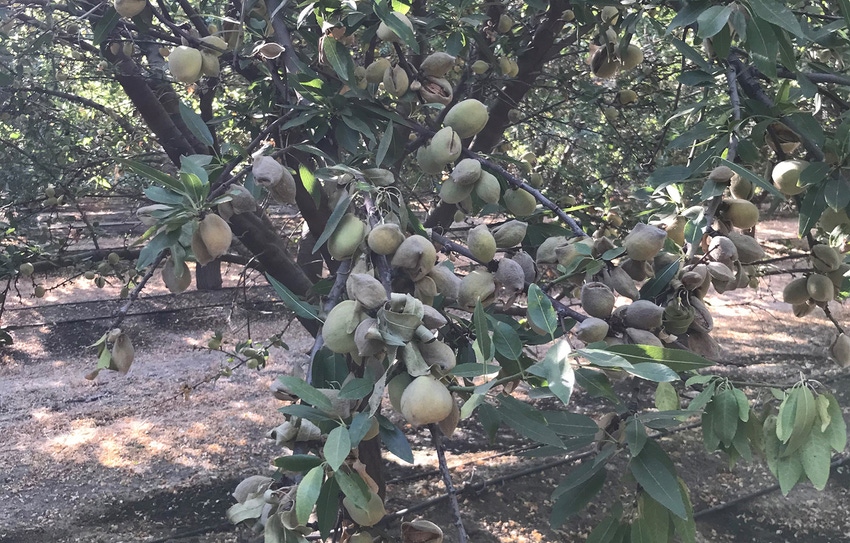
If it isn’t one problem, it’s another.
Cotton growers worry about the boll weevil. Corn farmers keep an eye out for borers. And while grape growers take precautions against end-of-season Botrytis bunch rot, tree nut growers have to keep an eye out for hull rot during Deep V Split as that crack in the hull provides an open door for both air- and soil-borne orchard fungi.
“By the end of the season, growers know whether or not they have hull rot in their trees because the fungi, attracted by the nutrients in the hull, will have invaded the canopy and released toxins that affect the spur on which the hull hangs,” says Mohammad Yaghmour, University of California Agriculture and Natural Resources advisor.
Unlike some diseases and pests, hull rot is not a threat to the current year’s crop, but it can be problematic as it affects shoots and twigs responsible for producing next year’s nuts, ultimately impacting yield in the process.
“Performing post-season winter sanitation is not only vital in reference to combatting Navel Orangeworm, it’s also necessary to fight against other diseases such as hull rot,” he says.
The Almond Board of California offers an appropriate quote from Mel Machado, Grower Relations Director at Blue Diamond: “Sanitation is the key to mitigating. Once mummy nuts are on the ground, destroy them with prejudice.”
While more research is needed to quantitatively rank varieties according to susceptibility in different regions of California, some almond varieties are observed to be more susceptible to hull rot than others. Current data shows the popular Nonpariel variety (along with Butte and Winters) fall victim easier than do Monterey, Carmel, and Fritz.
A trio of toxins are most responsible for orchard hull rot — air spores like Monilinia, found in wetter climates in the Sacramento Valley, and two soil fungi more prevalent in the San Joaquin Valley, all the way down to Modesto, Aspergillus niger and Rhizopus stolon, both of which can infect the same tree.
When Monilinia strikes, the hull displays a brown outside area with a companion fungal growth. “Twigs infected the previous year can still harbor the fungus going forward, as can infected mummy nuts from the last season — more reasons they should be discovered, removed, and destroyed during winter sanitation either through hand-poling crews or a second tree shake,” Yaghmour says. “The nuts should then be destroyed on the orchard floor via disc or flail mowing."
Aspergillus infestation
Aspergillus infestation is marked by dark black, powdery spores found between the hull and shell, carried from the soil into the tree by dust and wind gusts.
“We have cultural controls, like regulated deficit irrigation and properly-timed chemical controls depending on whether there are one or more pathogens involved," he says. "Deficit irrigation to generate mild-to-moderate stress begins at hull split with frequency maintained while volume is lowered."
Understand your soil profile, he advises. “The tree should consume root zone water while inducing mild stress that doesn’t negatively impact tree or yield, resuming normal irrigation right up to harvest dry down,” he says.
If combatting with chemicals, Rhizopus stolonifera can be managed by a single application at hull split while Monolinia requires earlier efforts, three or four weeks before split.
“It’s too late in the current season to do much about this year’s harvest, but forward thinking is always called for in this industry to ensure hull rot isn’t allowed to obtain a foothold,” Yaghmour says. “Don’t just rely on one method, use all the tools in the IPM toolbox, cultural and chemical along with regulated deficit irrigation and avoiding the application of too much nitrogen or over fertilizing which promotes the pathogens.”
For more news on tree nuts as reported by growers and farm advisors, subscribe to the Tree Nut Farm Press e-newsletter.
About the Author(s)
You May Also Like




